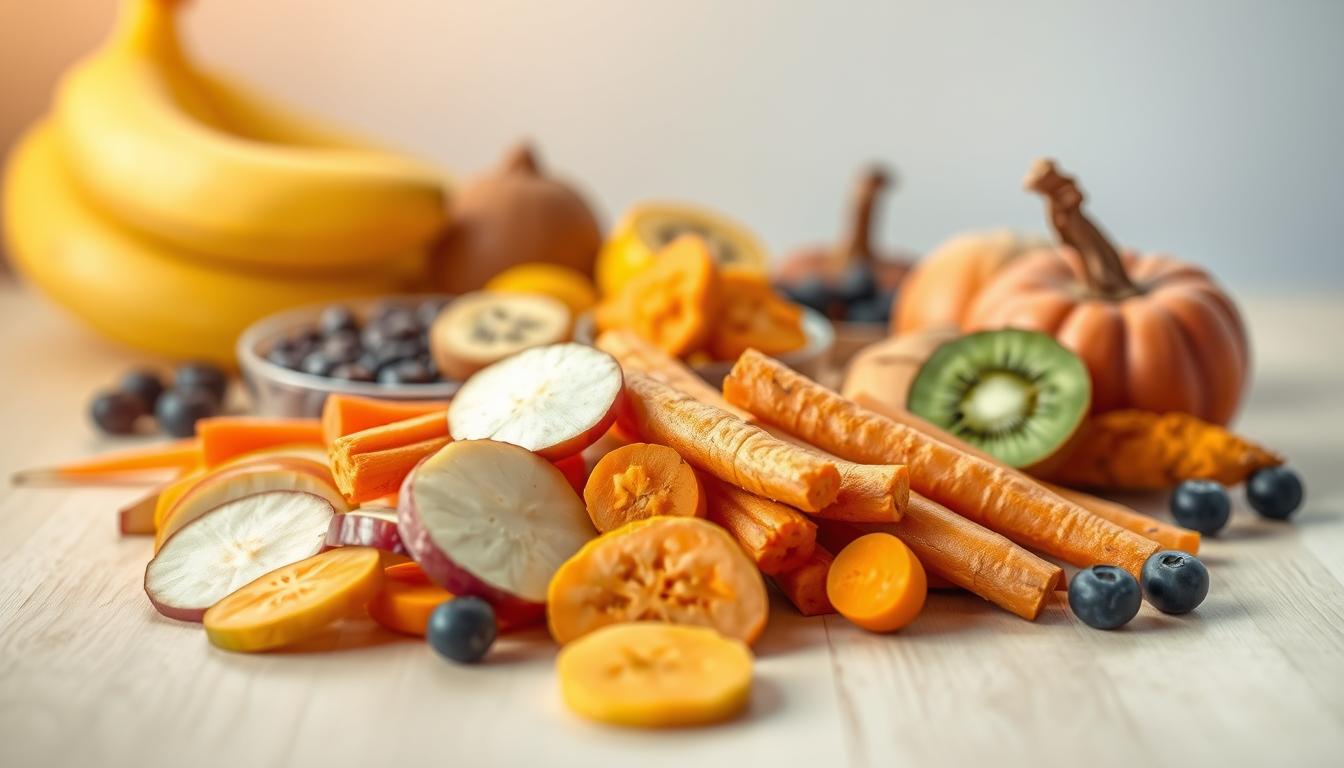Fiber Foods for Dogs: Keep Your Pup Healthy and Happy
Table of Contents
Watching your dog struggle with digestive issues is heartbreaking. I’ve been there, trying to help my dog feel better. I learned how important the right food is for their health.
Fiber is key for your dog’s digestive system. It helps with bowel movements and nutrient absorption. The right fiber can make a big difference in your dog’s energy and overall health.
This guide will show you the best fiber foods for dogs. We’ll look at scientific recommendations to keep your dog’s digestive system healthy. You’ll learn how to prevent digestive problems and improve your dog’s health.
Key Takeaways
- Fiber is essential for maintaining your dog’s digestive health
- Different types of fiber offer unique benefits for canines
- Proper fiber intake can prevent common digestive issues
- Natural food sources are the best way to introduce fiber
- Individual dog needs vary based on age and health condition
Understanding the Importance of Dietary Fiber for Dogs
Dietary fiber is key for your dog’s health and digestion. When picking high fiber dog food, know how different fibers meet your pet’s needs.
Dogs need a mix of soluble and insoluble fiber. These fibers help keep digestion running smoothly and boost overall health.
Types of Fiber: Soluble vs. Insoluble
Fiber has two main types, each with its own role in your dog’s diet:
- Soluble Fiber: Dissolves in water and feeds good gut bacteria
- Insoluble Fiber: Moves through the digestive system, helping with regular bowel movements
Benefits for Digestive System
Choosing the right high fiber dog food can help with weight, blood sugar, and stool health. Fiber is a natural aid for digestion, keeping your dog’s gut healthy.
| Fiber Type | Primary Function | Digestive Benefit |
|---|---|---|
| Soluble Fiber | Ferments in colon | Supports gut bacteria |
| Insoluble Fiber | Adds bulk to stool | Improves bowel regularity |
Impact on Gut Microbiome
A good mix of fiber can improve your dog’s gut health. Fiber’s prebiotics help grow good bacteria, boosting immunity and digestion.
“Proper fiber intake is key to maintaining your dog’s digestive wellness and long-term health.” – Veterinary Nutrition Experts
Signs Your Dog Needs More Fiber in Their Diet
Watching your dog’s digestive health closely is important. A diet rich in natural fiber is key to their well-being. Knowing when your dog needs more fiber can stop health problems early.
Look out for these signs that your dog might need a fiber supplement:
- Inconsistent Stool Patterns: Hard, dry stools or trouble passing them
- Frequent constipation or diarrhea
- Unexpected weight changes
- Visible discomfort when they poop
- Struggling too much in the bathroom
Your dog’s digestive system needs the right balance of nutrients. Without enough fiber, they can face many health issues. Keep an eye on their bathroom habits and energy levels.
“Fiber is the unsung hero of canine nutrition, supporting digestive health from the inside out.” – Veterinary Nutrition Expert
Talking to your vet is the best way to figure out what your dog needs. They can help you add more fiber to their diet or recommend supplements. This will be based on your dog’s specific health needs.
Fiber Foods for Dogs: Essential Sources for Better Health
Keeping your dog’s digestive system healthy is key. Fiber is vital for this, offering nutrients that boost overall health. Knowing the best fiber sources helps you pick the right treats and supplements for your dog.
Dogs need a diet rich in various fiber sources. Let’s look at the top options for better digestion.
Fruits: Nature’s Fiber Powerhouses
- Apples (without seeds): Low-calorie fiber source
- Blueberries: Packed with antioxidants and fiber
- Bananas: Soft, easy-to-digest fiber option
Nutritious Vegetable Fiber Sources
| Vegetable | Fiber Content | Additional Benefits |
|---|---|---|
| Carrots | High | Rich in beta-carotene |
| Green Beans | Moderate | Low-calorie option |
| Sweet Potatoes | High | Excellent nutrient profile |
Whole Grains for Digestive Support
Whole grains are great for your dog’s diet. Brown rice and oatmeal are high in fiber and nutrients. They help with digestion and can be part of homemade or store-bought treats.
Start adding new fiber sources slowly. Always talk to your vet to make sure your dog gets the right food.
Pumpkin: A Superfood for Canine Digestive Health

Pumpkin is a superfood that boosts gut health in dogs. It’s a vibrant orange vegetable full of nutrients. These nutrients can greatly improve your dog’s digestive health.
Pumpkin is rich in soluble fiber. This fiber helps your dog’s digestive system work better. It’s a great way to add fiber to your dog’s food.
Dogs with digestive problems find relief in pumpkin. It’s packed with nutrients. Here are some benefits:
- Supports healthy bowel movements
- Helps manage both diarrhea and constipation
- Provides essential vitamins and minerals
- Aids in weight management
When adding pumpkin to your dog’s diet, use pure pumpkin puree. Avoid sweetened pumpkin pie filling. Start with 1-2 tablespoons for medium-sized dogs. It’s full of:
- Vitamin A for immune support
- Potassium for muscle health
- Iron for blood circulation
- High moisture content for hydration
Your vet can tell you how much pumpkin your dog needs. Pumpkin is a natural way to improve your dog’s digestive health. It doesn’t have artificial additives.
Safe and Healthy Vegetables for Dog’s Fiber Intake
Choosing the right fiber foods for dogs can greatly improve their digestive health. Vegetables are a great way to increase your dog’s fiber intake and provide important nutrients. Knowing which vegetables are safe and nutritious helps you make a balanced diet for your pet.
Vegetables can be a natural and beneficial addition to your pet’s diet when looking for high fiber dog food. Not all vegetables are the same, and some are better for your dog’s health.
Green Beans and Carrots: Nutrient Powerhouses
- Green beans provide low-calorie fiber and essential vitamins
- Carrots offer beta-carotene and support dental health
- Both vegetables can be served raw or steamed
Sweet Potatoes and Broccoli: Fiber-Rich Options
- Sweet potatoes are packed with complex carbohydrates and fiber
- Broccoli provides antioxidants and supports digestive function
- Always cook these vegetables to improve digestibility
Proper Serving Sizes Matter
When adding fiber foods to your dog’s diet, portioning is key. Start with small amounts and gradually increase. Vegetables should make up no more than 10% of your dog’s daily diet. Talk to your vet to find the right serving size for your dog’s weight, age, and health.
Remember: Moderation is key when adding new foods to your dog’s diet.
Fruit-Based Fiber Sources for Your Dog

Discovering dog-friendly fiber sources can change your pet’s diet and health. Fruits are a great natural choice for a dog’s diet. Not all fruits are safe, but some are very good for your dog.
When picking fruits for your dog, choose these:
- Apples (without seeds)
- Bananas
- Blueberries
- Watermelon
Each fruit has special benefits for your dog. Apples give great fiber and clean teeth. Bananas have potassium and natural sugars. Blueberries have antioxidants, and watermelon helps with digestion.
It’s important to prepare fruits for your dog. Always wash them well, remove seeds and stems, and cut into small pieces. Start with a little to see how they react and avoid upset stomachs.
How much to give depends on your dog’s size:
- Small dogs: 1-2 small pieces
- Medium dogs: 2-3 pieces
- Large dogs: 3-4 pieces
Fruits should add to, not replace, your dog’s regular food. It’s important to keep things balanced for your dog’s health.
How to Introduce Fiber-Rich Foods to Your Dog’s Diet
Adding fiber to your dog’s diet needs careful planning and patience. It’s not about sudden changes. Instead, it’s about a strategic approach that helps their digestive system.
Gradual Introduction Strategies
Here are the key steps for introducing new fiber sources:
- Start with small amounts of fiber-rich foods
- Mix new ingredients with their regular meal
- Slowly increase portions over 1-2 weeks
- Keep portion sizes consistent
Monitoring Your Dog’s Response
It’s important to watch how your dog reacts to dietary changes. Look for these signs of successful fiber integration:
- Normal stool consistency
- Stable energy levels
- No digestive discomfort
- Consistent appetite
Always talk to your vet before making big changes to their diet. Each dog’s digestive system is different. A vet can help make sure the changes are safe.
Common Mistakes When Adding Fiber to Dog’s Diet
Adding fiber to your dog’s diet can be tricky. Many pet owners make mistakes that harm their dog’s digestion. Knowing these mistakes helps you give your dog the best nutrition.
Many dog owners add too much fiber too fast. This can cause problems like bloating, gas, diarrhea, and stomach pain. It can also make it harder for your dog to absorb nutrients.
Gradual introduction is key. Start with small amounts of fiber-rich foods and watch how your dog reacts. Not all dogs need the same amount of fiber.
Be careful of these common mistakes:
- Thinking all high-fiber human foods are safe for dogs
- Not considering your dog’s specific health needs
- Not keeping your dog hydrated when adding fiber
- Not talking to a vet
Your vet can give you advice on the best fiber supplement for your dog. They can help you find the right amount based on your dog’s age, weight, and health.
Remember: Balance is crucial when introducing new dietary elements to your dog’s nutrition plan.
Senior Dogs and Fiber Requirements
As your dog gets older, their diet needs change a lot. It’s very important to know about fiber in their food. This helps keep their digestive system healthy and them feeling good.
Older dogs face many digestive problems. These can be helped by the right fiber dog treats and food. Dogs are usually considered seniors when they’re about 11 years old. At this age, their bodies work slower and they digest food less well.
Age-Specific Dietary Considerations
Senior dogs need a special diet. Their fiber needs are different from younger dogs because of changes in how they digest food. Here are some important things to think about for your aging friend:
- They need fewer calories because they don’t burn them as fast
- They might get constipated more easily
- They make fewer digestive enzymes
- They might have trouble with their weight
Adjusting Fiber Intake for Older Dogs
To help your senior dog’s digestive health, try these fiber tips:
- Start with small amounts of fiber-rich foods
- Choose fiber that’s easy for them to digest
- Talk to your vet about what they need to eat
- Watch how they react to new foods
Good fiber sources for senior dogs include pumpkin, sweet potatoes, and special senior dog foods with the right amount of fiber. Always add new foods slowly and watch for any signs of upset stomach or digestive issues.
Proper nutrition is the key to supporting your senior dog’s health and vitality.
Supporting Your Dog’s Digestive Health with Proper Fiber Balance
Keeping the right fiber balance is key for your dog’s gut health. Their digestive system needs a special diet that goes beyond just feeding them.
Fiber is important for your dog’s digestive health. Not all fibers are the same. Finding the right mix can greatly improve your dog’s health.
- Check your dog’s diet for fiber
- Watch how they react to diet changes
- Think about fiber needs based on age
- Talk to a vet nutritionist
It’s all about finding the right amount and watching closely. Too little fiber can cause problems, while too much might block nutrient absorption. Your dog’s needs change with age, weight, and health.
“A balanced diet is the foundation of your dog’s digestive health” – Veterinary Nutrition Experts
Start slow when adding new fiber foods. Try adding pumpkin, sweet potatoes, and green beans. Look for signs of comfort or discomfort and adjust as needed.
Some dog foods have the right amount of fiber. But, some dogs might need extra. Always choose natural, high-quality fiber sources that meet your dog’s digestive needs.
Conclusion
Keeping your dog’s digestion healthy is all about the right diet. Dogs need a mix of nutrients, and fiber is key. Knowing where to find fiber and its benefits helps you choose the best food for your dog.
Every dog is different, so their fiber needs vary. Vets suggest a diet plan that fits your dog’s age, size, and health. Adding fiber-rich foods slowly and watching how your dog reacts helps them adjust to a better diet.
Learning about fiber can really improve your dog’s health. You can use foods like pumpkin, sweet potatoes, lean proteins, and whole grains. Always talk to your vet for the best advice on your dog’s diet.
Showing love to your dog means caring for their diet. By focusing on fiber, you help them stay full of energy, keep a healthy weight, and live a better life.
There are no reviews yet. Be the first one to write one.


